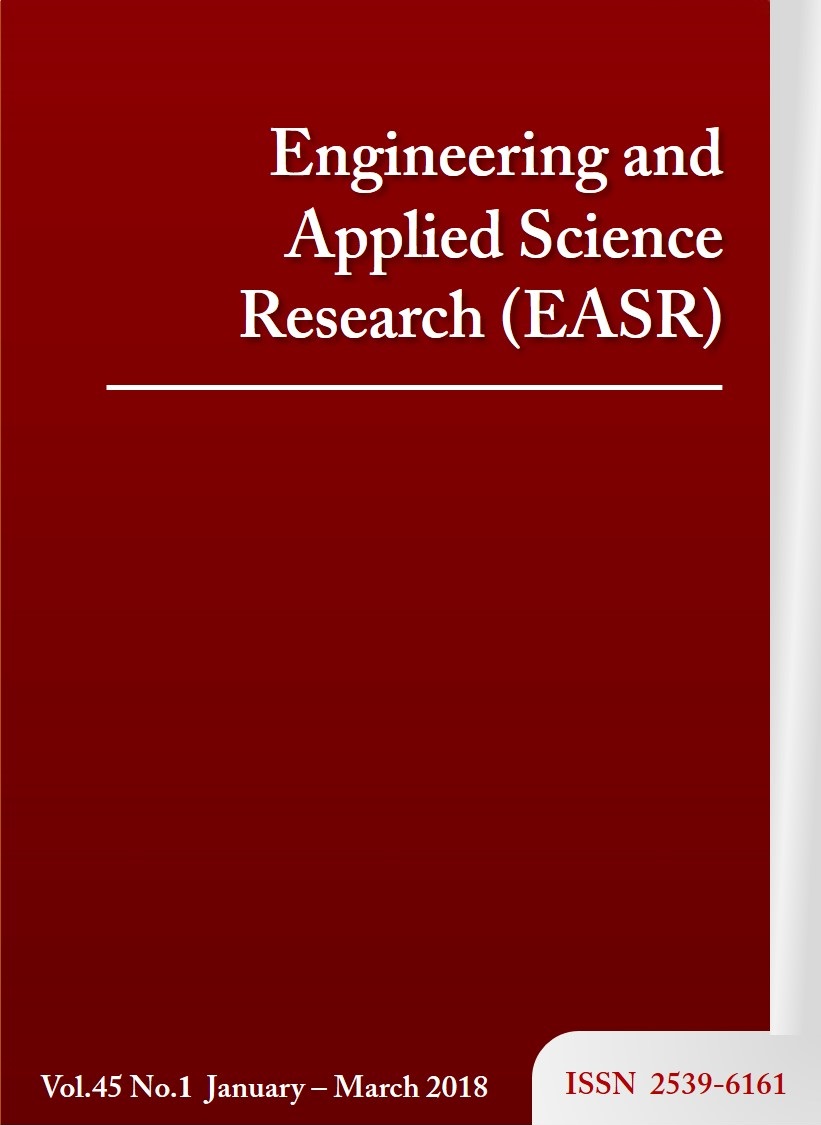Concrete columns with discrete confinement by metal sheets subjected to uniaxial compression: derivation toward design rule
Main Article Content
Abstract
This paper applied a nonlinear finite element model to study the effect of discrete metal sheet confinement on the uniaxial compressive strength of concrete columns. The columns in this study had circular cross sections with a diameter of 15 cm and a height of 75 cm. Concrete columns with various discrete wrap patterns were computationally simulated and found to be consistent with available experimental results. The results from the three-dimensional finite element modelling showed the effect of the bi-axial response of the metal sheet when it acted as confining material. An analytical procedure outlined in this study was used to determine the effective confining pressure in concrete. This work demonstrates that the development of the strength of a concrete column with discrete metal sheet confinement depends on its size, spacing and the number of the applied metal sheet layers. Strength prediction equations for study columns were derived as an example adaptable to formulate necessary design rules.
Article Details
This work is licensed under a Creative Commons Attribution-NonCommercial-NoDerivatives 4.0 International License.
References
[2] Xiao Y, Wu H. Compressive behavior of concrete confined by carbon fiber composite jackets. J Mater Civ Eng. 2000;12(2):139-46.
[3] Harajli MH. Axial stress-strain relationship of FRP confined circular and rectangular concrete columns. Cement Concr Compos. 2006;28:938-48.
[4] Wu G, Lu ZT, Wu ZS. Strength and ductility of concrete cylinders confined with FRP composites. Construct Build Mater. 2006;20:134-48.
[5] Park TW, Na UJ, Chung L, Feng MQ. Compressive behavior of concrete cylinders confined by narrow strips of CFRP with spacing. Compos B Eng. 2008;39:1093-103.
[6] Rocca S, Galati N, Nanni A. Review of design guidelines for FRP confinement of reinforced concrete columns of noncircular cross sections. J Compos Construct. 2008;12:80-92.
[7] Moghaddam H, Samadi M, Pilakoutas K. Compressive behavior of concrete actively confined by metal strips, part B: analysis. Mater Struct. 2010;43:1383-96.
[8] Moghaddam H, Samadi M, Pilakoutas K, Mohebbi S. Axial compressive behavior of concrete actively confined by metal strips, part A: experimental study. Mater Struct. 2010;43:1369-81.
[9] Khamthong M, Boonpichetvong M, Pannachet T. Axial compression strengthening of concrete columns confined by metal sheet. Proceedings of the Seventh Annual Concrete Conference (ACC-7); 2011 Oct 19-21; Rayong, Thailand. 2011. [In Thai].
[10] Wangsa K, Inla T, Charoensri P. Study on increasing efficiency of metal-sheet bonded square concrete columns under uniaxial compression. Undergraduate Engineering Student Project Report. Khon Kaen, Thailand: Khon Kaen University; 2011. [In Thai].
[11] Boonyaratana K, Pinitkarnwatkul S, Janpila A. Effect of concrete compressive strength on axial load carrying capacity of concrete column strengthened with metal sheets. Undergraduate Engineering Student Project Report. Khon Kaen, Thailand: Khon Kaen University; 2012. [In Thai].
[12] Korbkeu A, Thongsila Ch, Tosomboon I. Effect of metal sheet arrangement on load carrying capacity of metal sheet confined columns. Undergraduate Engineering Student Project Report. Khon Kaen, Thailand: Khon Kaen University; 2013. [In Thai].
[13] Positong A, Pannachet T. Use of metal sheet strips to increase compressive strength of concrete columns. Proceedings of the Nineteenth National Convention on Civil Engineering; 2014 May 14-16; Khon Kaen, Thailand. Khon Kaen: Khon Kaen University; 2014. [In Thai].
[14] Hongsinlark N, Boonpichetvong M, Pannachet T. Finite element modeling of axially loaded concrete columns with metal sheet confinement. KKU Eng J. 2014;41(4):517-25. [In Thai].
[15] Boonpichetvong M, Pannachet T, Pinitkarnwatkul S. Finite element modeling of concrete specimens confined with metal sheet strips. Int J Tech. 2016;7:1132-40.
[16] MSC Software Corporation. Marc 2010 volume A : theory and user information. Taipei: MSC Software Corporation; 2010.
[17] Popovics S. A numerical approach to the complete stress-strain curve of concrete. Cement Concr Res. 1973;3(5):583-99.
[18] Lertsrisakulrat T, Watanabe K, Matsuo M, Niwa J. Experimental study on parameters in localization of concrete subjected to compression. J Materials Conc Struct Pavements. 2001;669:309-21.
[19] Rots JG. Computational modeling of concrete fracture. Delft, Netherlands: Delft University of Technology; 1988.
[20] ACI Committee 318. 318-11: Building code requirements for structural concrete and commentary. USA: American Concrete Institute; 2011.
[21] Sika (Thailand) Company Ltd. Sikadur-31 CF normal. Product data sheet. Chonburi, Thailand: Sika (Thailand) Company; 2011.
[22] Bluescope Steel Company Ltd. ZINCALUME steel G550. Product data sheet. India: Bluescope Steel Company; 2004.
[23] Richart FE, Brandtzaeg A, Brown RL. A study of the failure of concrete under combined compressive stresses. Technical reports. Engineering Experimental Station Bulletin No.185. Illinois, USA: University of Illinois; 1928.
[24] Lam L, Teng JG. Design-oriented stress-strain model for FRP confined concrete. Construct Build Mater. 2003;17(6-7):471-89.
[25] Mander JB, Priestley MJN, Park R. Theoretical stress-strain model for confined concrete. J Compos Construct. 1988;114(8):1804-26.
[26] Richart FE, Brantzaeg A, Brown RL. The failure of plain and spirally reinforced concrete in compression. Technical reports. Engineering Experiment Station Bulletin No. 190. Illinois, USA: University of Illinois; 1929.


